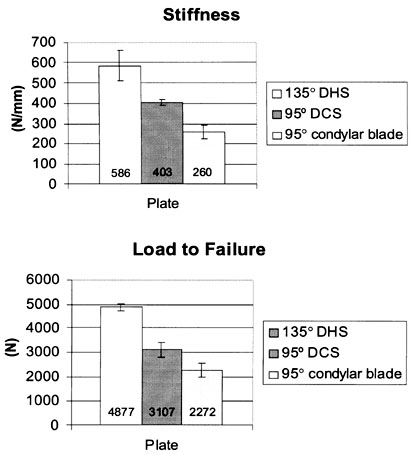
Session V - Femur
Biomechanical Comparison of Plates Used in the Treatment of Unstable Subtrochanteric Femur Fractures
Douglas W. Lundy, MD; Jorge I. Acevedo, MD; Timothy M. Ganey, PhD; John A. Ogden, MD, Georgia Baptist Medical Center, Atlanta, GA; William C. Hutton, DSc, Emory University, Atlanta, GA
Purpose: Subtrochanteric femur fractures with medial comminution (32-B3.1) are subject to tremendous compressive loads. Although intramedullary fixation is preferred when stabilizing this injury, extension of the fracture into the piriformis fossa precludes this option. The purpose of this study was to compare the biomechanical properties of the 95° condylar blade plate, 95 condylar screw plate, and the 135° compression hip screw when used to treat subtrochanteric femur fractures with loss of medial cortical continuity.
Methods: Fifteen composite femora, constructed to simulate the biomechanical properties of real bone, were tested to ensure they had equal stiffness qualities. A thirty-degree wedge of bone (apex lateral) including the lesser trochanter was removed producing a subtrochanteric femur fracture with loss of medial contact. Each of the femora was fixed with either the Synthes 95° condylar blade plate, the Synthes 95 DCS, or the Synthes 135° DHS. The fifteen femora were mounted in gypsum cement at 25° of varus in the coronal plane reproducing the vector of load transmission across the proximal femur. The specimens were placed into the MTS machine and loaded in axial compression to 400 N. This was repeated five times to determine the stiffness of the femur-plate construct. The construct was then loaded to failure, which was determined by a deflection in the load-displacement curve. The results were subjected to ANOVA.
Results: The DHS-femoral construct was the stiffest (586 N/mm), followed by the 95° DCS (404 N/mm), and the 95° condylar blade plate (260 N/mm). The DHS also had the highest ultimate load-to-failure (4877 N), followed by the 95° DCS (3107 N), and the 95° condylar blade plate (2272 N). All of the plates failed by bending at the osteotomy site. All of these differences were statistically significant (p<0.0001).
Discussion and Conclusion: Our study suggests that the Synthes 95 DCS is biomechanically superior to the Synthes 95° condylar blade plate when used in the treatment of unstable subtrochanteric femur fractures. This model may not be completely appropriate for testing the 135° DHS since the hard plastic "cortex" of the model prevented cut out of the screw. In clinical application, the DCS has been used successfully by several authors, and it is easier to insert than the 95° condylar blade plate.
